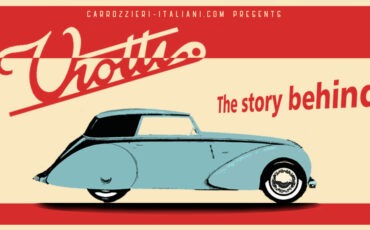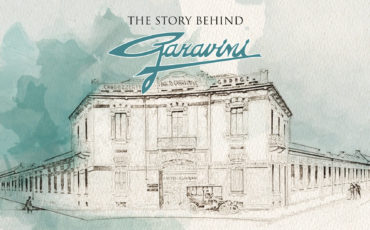
Carrozzeria Fissore, established in 1921 by Bernardo Fissore and his brothers in Savigliano, holds a distinguished place in the history of Italian automotive craftsmanship. Specializing in bespoke bodywork, the company became renowned for its exceptional quality and innovative designs, partnering with prestigious manufacturers like Fiat, Maserati, and De Tomaso. During its peak in the 1960s, Fissore was synonymous with luxury and exclusivity, producing iconic vehicles and special commissions. Despite the passing of its founder in 1973, the company continued its operations until 1984. In 1976, the Fissore legacy was carried forward with the creation of Rayton Fissore, which specialized in custom vehicles and special projects.
The Origins
Carrozzeria Fissore’s history is deeply connected to Savigliano. In 1921, the four Fissore brothers—Bernardo, Antonio, Giovanni, and Costanzo—founded a workshop for animal-drawn vehicles, leveraging their experience in wheelwright shops. Costanzo had also trained in aviation at Officine di Savigliano. They chose Savigliano for its industrial opportunities over more agricultural areas.
Bernardo, the eldest, took over the Montaldi wheelwright shop in 1921 with his brothers’ support. Their high-quality craftsmanship soon gained recognition, leading them to move to a larger space on Via Chianoc in 1927, where they set up specialized departments for painting, carpentry, and upholstery.
As Italy industrialized, the number of automobiles grew rapidly, from 123,000 in 1930 to a booming transport sector. The Fissore brothers, employing about ten workers, gradually transitioned into automotive bodywork, starting with repairs and later customizing vehicles. A key milestone came with an order from Chiaffredo Flesia & Sons, Ford’s Cuneo representative, who supplied Ford Model T chassis for truck conversions. This experience solidified their move into automotive body manufacturing.
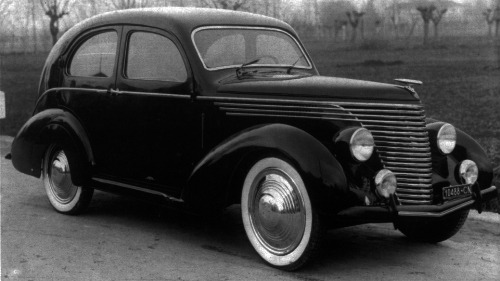
To build expertise, the brothers hired specialists from Turin, including a designer from Stabilimenti Farina, a painter, an upholsterer, and a metalworker. This strategy fostered a highly skilled workforce, elevating both the company and Savigliano’s reputation.
By the early 1930s, Italy was rapidly improving its road networks, fueling demand for transportation services. Encouraged by steady work from rental companies, couriers, and transport firms, the Fissore brothers fully embraced their new role as coachbuilders. They built customized coupé de Ville models on Fiat 501 and Fiat 503 chassis, as well as trucks and vans, showcasing their adaptability to an evolving market.
Expanding business led the Fissore brothers to purchase land on Via Torino in 1935, an area previously home to various industries. They repurposed existing structures for carpentry, upholstery, metalwork, and painting, continuously upgrading the facilities until a full modernization in the 1960s.
By 1936, Carrozzeria Fissore was officially registered, with Bernardo emerging as the company’s leader. His eldest son, Mario, trained as a bodywork designer, gaining expertise in custom vehicle production and later driving the company’s creative evolution after World War II.
During the late 1930s, Fissore expanded its custom-built offerings, including Fiat 508 (1937) and Fiat 524 (1937) special models, alongside truck cabins, luxury hotel vehicles, hearses, postal vans, and military supplies like wheelbarrow wheels and ammunition boxes.
With strong craftsmanship and innovation, Carrozzeria Fissore laid the foundation for its future in the automotive industry.
The War Years
When Italy entered World War II on June 10, 1940, industries shifted to military production. Carrozzeria Fissore, while continuing to serve private clients, received government orders and was classified as a pre-auxiliary war company. Initially, they supplied refrigerated vehicles on Bianchi Miles chassis for North Africa.
After Allied bombings damaged Turin’s Viberti plant, its owner, Candido Viberti; who had ties to Fissore from his time at Officine di Savigliano; turned to them for help. Fissore completed military contracts, including surgical units and mobile workshops on Lancia 3 RO trucks.
In September 1943, following Italy’s armistice, German forces occupied the Fissore factory. Both the Luftwaffe and Wehrmacht seized ongoing productions, forcing the company’s 36 employees to repair and repaint military vehicles. Meanwhile, the war directly affected the Fissore family—Bernardo’s sons Mario and Giusto were deployed for years, and his younger son, Sergio, was sent to Turin’s Ellena coachbuilding firm to train in design before also being called to the front.
Despite wartime struggles, the company maintained an optimistic outlook. Between 1943 and 1945, they expanded facilities and converted nearby buildings into housing for the family. Remarkably, Fissore emerged from the war without major losses or damage, positioning itself strongly for the post-war reconstruction era.
Post-War Years (1945-1950)
By 1944, automobile production in Italy had reached its lowest point due to the war. Many companies suffered severe damage from bombings and requisitions, but Carrozzeria Fissore, with its facilities intact and a team of forty workers, was well-positioned for recovery.
The company initially focused on industrial vehicles and public transport, but also explored diversification, producing electric kitchen stoves. These stoves, available in various sizes and power levels, were manufactured in a dedicated facility, providing a temporary but successful revenue stream. However, once the automotive market revived, the company returned to its core business.
A turning point came with the rise of the station wagon, then known as the “giardinetta.” This versatile vehicle, promoted by carrozziere Vittorino Viotti, catered to professionals needing multipurpose transportation. Recognizing its potential, the Fissore brothers collaborated with renowned designer Mario Revelli di Beaumont. Mario Fissore trained at Revelli’s studio between 1947 and 1948 to refine his design expertise.
The prototype, based on the Fiat 1100 L chassis, was intended to be entirely metal, with only the doors featuring wooden paneling in line with American trends. However, the final version retained a wooden structure but was fully covered in sheet metal.
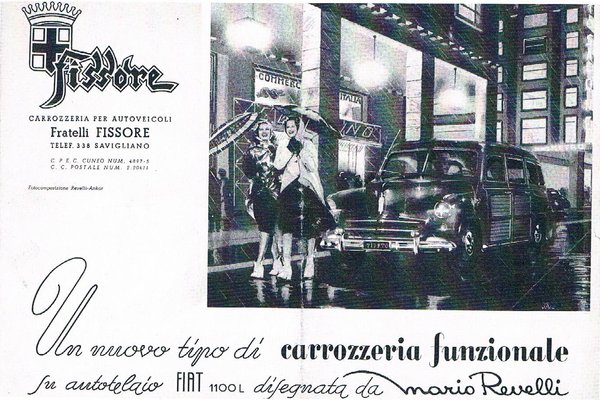
The official debut took place at the 31st Turin Auto Show in September 1948, the first post-war edition. The event saw multiple coachbuilders presenting station wagons, with Fissore and Monterosa pioneering all-metal designs. Industry publication “L’Auto Italiana” praised Fissore’s approach, noting their departure from decorative wooden paneling in favor of full paintwork, a move well received by journalists and the public alike.
The success of the station wagon concept led Fissore to expand into ambulances and other specialty vehicles, capitalizing on the giardinetta’s adaptability. Meanwhile, in 1949, the company ventured into agricultural machinery, establishing Ital Fissore (Industria Trazione Agricola Leggera) to produce the “Rubino” tractor, designed by geometer Audisio of Pinerolo.
Unveiled at the 1950 Milan Fair, the Rubino was a compact, practical machine for vineyard and hillside farming. Featuring a 427cc single-cylinder two-stroke engine with 10 horsepower, it was marketed internationally, drawing interest from England, Belgium, France, and Argentina.
Despite initial commercial success, mechanical issues with the transmission and engine surfaced, making maintenance costly. By 1953, these challenges forced Ital Fissore into liquidation, though the losses were absorbed by Carrozzeria Fissore’s growing automotive business. The company had nonetheless gained valuable engineering experience, setting the stage for future endeavors.
The 1950s: A Decade of Creativity
The 1950s marked a period of remarkable creativity and success for Italian coachbuilders. In 1951, G. Lurani described this era as “the moment of Italian coachbuilding” in “L’Auto Italiana,” highlighting the nation’s innovative designs and elegant craftsmanship. Fissore thrived in this environment, expanding both its production capabilities and reputation.
A key development was the rise of advertising vehicles, which Fissore embraced with enthusiasm. The company showcased its prowess at the 1950 Sanremo Advertising Vehicle Contest, winning numerous awards with five specially designed vehicles. A standout moment was the unveiling of the Fiat 1400 Fissore station wagon, used by the event’s organizing committee.

In subsequent years, Fissore produced numerous advertising and demonstrative vehicles, crafting unique designs for brands like Smacchiolina, Liquore Strega, and Durban’s toothpaste. Their work was widely praised, with critics recognizing the company’s innovation and technical skill.
By the late 1950s, Fissore’s workforce had tripled, reaching 124 employees by 1957. Investments in modernizing facilities and expanding production lines reflected the company’s sustained growth. Notable milestones included the presentation of the Martini & Rossi promotional bus at the 1958 Turin Auto Show and the continued development of ambulances, hearses, and light commercial vehicles.
Further cementing its status, Fissore welcomed Argentine racing legend Juan Manuel Fangio for a factory tour in 1955 and inaugurated a modern industrial complex in 1956. That year, Bernardo Fissore was honored with the title of Cavaliere al Merito della Repubblica Italiana, underscoring the company’s impact on Italian industry.
The 1960s - A New Era for Carrozzeria Fissore
As the 1960s began, Carrozzeria Fissore found itself in possession of an expansive, modern facility capable of accommodating more than two hundred employees. This setup enabled the production of fifty vehicles per month, which were distributed across a variety of models, including ambulances (Fiat 1100 H, 1200, 1800, 2100, 2300, 600 M/D, 1100 T), Fiat 1500 coupés, Mercedes station wagons, commercial vans (Fiat 600 M/D and Sabrina), and coupés and convertibles of the Auto Union DKW group. These latter models marked a significant promotional milestone for Fissore, particularly when they were unveiled at the 41st Italian Automobile Show in Turin between October and November of 1959. The introduction of the DKW vehicles bolstered the company’s international presence, drawing attention from numerous European and South American subsidiaries of Auto Union, which eventually led to consultancy and collaboration requests.
In 1960, a notable agreement was struck with the Spanish company Inauto (Industrias Auxiliares del Automóvil, based in Vitoria), a manufacturer specializing in special-purpose vehicles like minibuses, ambulances, and vans. Inauto, part of the Imosa group (Industrias del Motor), contracted Fissore to design and develop a new commercial vehicle for the Auto Union DKW brand. Fissore contributed engineers, designers, and metalworkers who worked on the project at Inauto’s Vitoria headquarters. From conceptual sketches to full-scale plans, Fissore’s team created the Auto Union DKW F 1000 L prototype, which was unveiled in 1963 for the Spanish market, with significant export potential due to Auto Union DKW’s international reach.
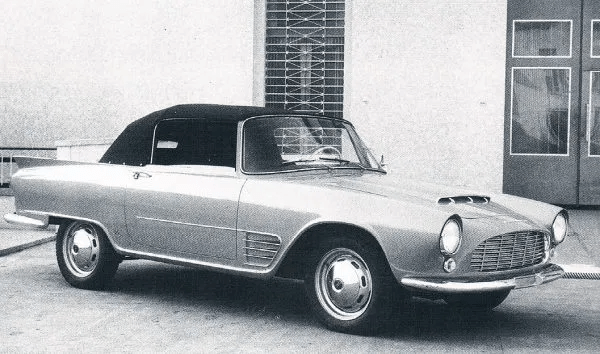
The F 1000 L was presented in a variety of body styles and made its Italian debut at the 45th Turin International Automobile Show in 1963. However, a prototype for a “hardtop” version of the DKW Fissore Spider, proposed by Inauto, did not reach mass production. Nevertheless, the coupé and spider versions of the Auto Union DKW Fissore drew attention even beyond Europe, spurring commercial initiatives in Argentina. There, the Argentine company Face (Fábrica Argentina de Carrocerías Especiales) signed a license agreement with Fissore to produce these models. Initially, complete bodies were shipped from Savigliano, Italy, and assembled on DKW chassis in Santa Fe, Argentina. Over time, the assembly and painting were moved to Argentina, with Fissore’s technical team assisting in the setup of the production area, including machinery for frame construction and the installation of Italian-sourced sheet metal.
This marked the beginning of a true “industrial design” experience, where Fissore not only exported Italian style but also leveraged its expertise in small-series production. While the Argentinian venture concluded in 1964, another significant international partnership unfolded in Brazil. In 1961, Vemag (Veículos e Máquinas Agrícolas), the Brazilian subsidiary of Auto Union DKW, contacted Fissore to design a luxury version of the DKW 1000 sedan, aimed at the Brazilian market. The contract involved providing technical assistance for body design, including the right to use Fissore’s registered trademark and the deployment of Italian experts to Brazil.
The resulting vehicle was showcased at the 3rd São Paulo International Motor Show and became highly popular, gracing the cover of Brazil’s prestigious “Quatro Rodas” magazine. Produced from 1963 to 1967, the DKW 1000 became a symbol of luxury, with its distinctive Italian design admired by a sophisticated clientele. However, following the acquisition of Auto Union by Volkswagen in 1965, the DKW production line in Brazil was phased out. Despite the discontinuation of the DKW 1000, Fissore’s collaboration with Vemag was crucial in building its reputation as an industrial design leader.

The Brazilian experience also had an immense impact on Fissore, both technically and personally. Many Savigliano workers were involved in the planning and implementation of production processes in Brazil, providing training for Vemag’s local workforce. Moreover, Fissore’s reputation was further enhanced through interviews and features in the Brazilian press, including prominent publications such as “Quatro Rodas” and “Jornal do Brasil.” A particularly noteworthy event occurred when Bernardo Fissore was invited to speak at the São Paulo Polytechnic School about Italian style, focusing on automotive design, a field in which Italy was regarded as a global leader.
In addition, Fissore completed a prototype designed by Brazilian architect Arí de Rocha. This model, called the Fissore Aruanda, was a monovolume city car that earned de Rocha the prestigious Lucio Meira Prize in 1963. The recognition helped cement Fissore’s standing as a premier collaborator for cutting-edge automotive design.
By the mid-1960s, Fissore had fully embraced its role as an industrial manufacturer. With significant investments in a new paint shop, which featured a continuous cycle system for synthetic low-temperature paints, and a reorganization of the production workflow, Fissore’s operations in Savigliano became truly industrialized. Despite this shift, the company continued to produce exclusive limited-run models, such as the Fiat 1600 coupé and spider, and the GT 1600 for Osca. These vehicles, although produced in small numbers, attracted the attention of a discerning and high-end clientele, who appreciated their understated elegance and versatility.
During this period, the Fissore name gained international acclaim through various collaborations with leading car manufacturers. Notably, prototypes for De Tomaso (Vallelunga, 1964) and collaborations with British companies such as Elva Engineering (1964) and TVR (1965) marked the beginning of an enduring partnership with French designer Trevor Fiore. Despite the acclaim these projects garnered, none of them led to large-scale production, as many were impacted by changing corporate strategies or financial difficulties within the partner companies.
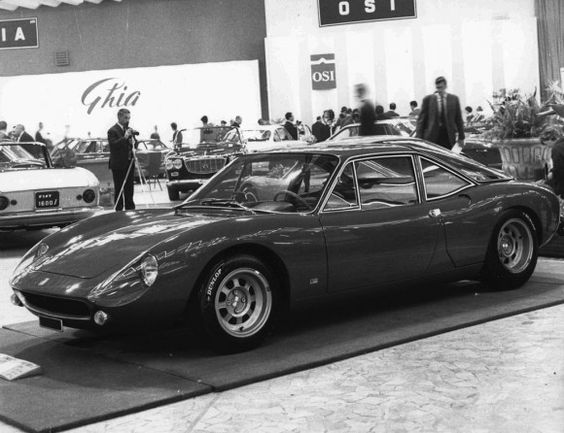
For example, Osca’s 1600 GT, produced between 1962 and 1963, was a notable success. The Fissore-bodied version was praised for blending sporty performance with comfort, but production ceased when the Maserati brothers sold their company to MV Agusta. Similarly, while the De Tomaso Vallelunga prototype enjoyed critical success, its production was halted after the company was acquired by Ghia. The Elva GT 1600, shown at the 1964 London Motor Show, saw limited production, and the Trident from TVR, despite its stylish design, also struggled in the market due to the company’s financial challenges.
Nonetheless, the 1960s were a highly productive and transformative period for Fissore. With a reputation as a leader in small-series production and industrial design, Fissore attracted increasing attention from both domestic and international automotive manufacturers. The company’s ability to design, produce, and refine vehicles efficiently was critical to its success, and the demand for its services continued to grow.
By the end of the decade, Fissore’s ability to combine artistic design with industrial expertise had made it a go-to partner for automotive companies across the globe. The company’s influence extended even further with projects in Japan and a new collaboration with Swiss manufacturer Peter Monteverdi, who sought Fissore’s assistance in building high-performance luxury vehicles to compete with established names like Ferrari and Lamborghini. The Monteverdi 375 L, equipped with a Chrysler 7.2-liter engine, was first unveiled at the 1969 Geneva Motor Show. The partnership continued throughout the 1970s, cementing Fissore’s reputation as a global leader in luxury and performance automotive design.
As the decade drew to a close, Carrozzeria Fissore had firmly established itself as a key player in the global automotive industry, with its technical expertise, innovative designs, and industrial capabilities allowing it to thrive in a rapidly evolving marketplace.
From Family Leadership to Transformation
The history of Carrozzeria Fissore took a significant turn in December 1968 with the formation of the company under the name “Fratelli Fissore.” The initial capital was set at 135,000,000 lire, and soon after, the business was divided among the Fissore family members. After liquidating the shares of Antonio Fissore’s group, the shares were distributed as follows: Fissore Demordo’s family received its share, Fissore Giovanni’s family acquired 30%, and Fissore Costanzo’s family retained 20%.
The leadership was also restructured, with Mario Fissore, the most senior administrator, continuing his technical and workshop duties, while Eraldo Fissore handled administrative and commercial functions. Sergio Fissore, along with Renato Fissore, assisted in the workshop direction, although without specific assignments.
In 1970, the company’s structure began shifting toward the modern era with a major decision: on April 11, 1970, a meeting was held to convert the company into a public limited company (SpA), which became operational in 1971. At the first board meeting of the SpA, held on September 17, 1971, Mario Fissore was appointed president, and Renato Fissore vice president.
With the new structure in place, Carrozzeria Fissore tried to adjust to the changing economic climate, particularly the global oil crisis that severely impacted luxury car production. The company transitioned from producing high-end vehicles for Monteverdi to manufacturing more standardized vehicles, such as the Fiat 128 and 127 in modified versions. In a stroke of creativity, Fissore introduced the Fiat 127 Gipsy, a torpedo-bodied vehicle aimed at the growing leisure car market, similar to the French Citroën Mehari. This innovation was a precursor to the popular Fiat Panda, which inherited several of its design traits.
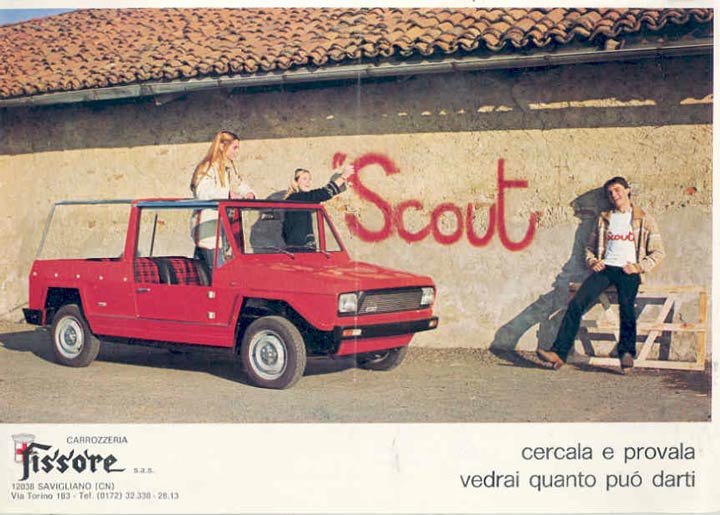
In the same period, the company began experimenting with new materials like fiberglass-reinforced plastic and manual molding processes, which would later be adopted by other car manufacturers. The Gipsy, later renamed Scout, was a significant success, attracting a broad range of customers, including VIPs and media attention. It was featured in numerous publications, such as the German magazine Form, which praised its originality and versatility.
Tragedy struck the family on January 3, 1973, when Bernardo Fissore, the eldest of the Fissore brothers and one of the founding members of the company, passed away in a tragic gas leak accident in Sanremo. His death marked the end of an era, leaving a leadership void in the company, as Bernardo had always been the glue that held the family business together, managing internal conflicts and leading the company through difficult times.
Later that year, in 1973, a significant shift in the company’s ownership occurred when the heirs of Giovanni Fissore sold their 20% stake in the company to the Carrozzeria Mediterranea (CM) from Atessa (Chieti). This change introduced new influences into the company, with the board appointing new members: Gregorio Bernardi as president, and Fernanda Fissore and Eraldo Fissore as councillors.
This marked the beginning of a turbulent period. The new partnership with CM suggested the creation of a second production facility, but the collaboration would soon falter. In early 1974, Fernanda Fissore took over as president following Gregorio Bernardi’s resignation due to health issues. Despite efforts to expand and strengthen ties with CM, by the middle of 1974, CM withdrew its interest in the company, leaving Fissore to deal with a severe economic downturn.
Struggles, Innovation, and the Birth of Rayton Fissore
In the mid-1970s, the auto industry faced a severe slump, and Fissore was no exception. The company grappled with financial difficulties, strained relations with suppliers, and a significant reduction in market demand. In response to these challenges, a new majority group, led by Bernardi, Mario, and Fernanda Fissore, decided to sell their shares to Eraldo Fissore and his family, marking the foundation of a new company: Rayton Fissore.
This new chapter for the Fissore family led to the creation of Rayton Fissore in 1976, based initially in Savigliano, later relocating to Cherasco. The company initially focused on special vehicle designs and developed the Magnum, a successful off-road vehicle. Rayton Fissore quickly gained recognition for its work, collaborating with major automotive brands, including Fiat, Lancia, Iveco, and Ferrari. However, by 1987, Rayton Fissore’s leadership shifted away from the Fissore family, as the company was sold and underwent numerous changes in ownership.
Despite the shift in focus and the new direction, Carrozzeria Fissore continued to innovate and adapt. In 1976, the company produced a new prototype for Monteverdi’s Safari, a 4×4 vehicle inspired by the Range Rover. The project marked a renewed collaboration with the Swiss manufacturer and served as an example of the continued relevance of the Fissore design expertise.
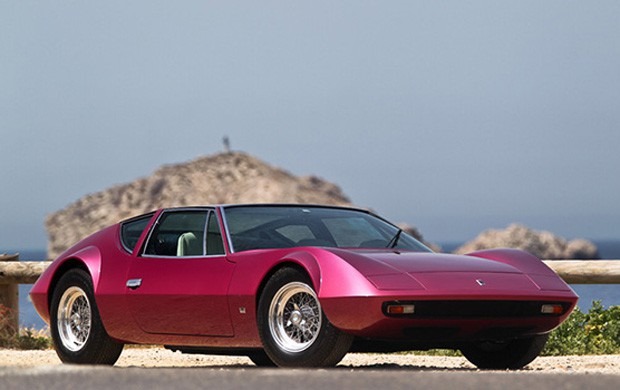
During this time, Monteverdi also introduced the Hai 450 SS in 1970, a vehicle with impressive specifications, including a 450 hp engine and a top speed of 280 km/h. Despite its aggressive styling, the vehicle was produced in limited quantities. The Hai 450 was followed by a cabriolet version of the 375 and a High Speed 375/4 limousine. Throughout these years, the Fissore family continued to contribute their design talents to Monteverdi’s cars, even as the company experienced a decline in production during the early 1970s, partially due to the oil crisis.
By the late 1970s, Fissore’s collaboration with Monteverdi reached new heights, with the creation of the Military 230 M, a rugged 4×4 vehicle that was also produced in civilian versions. A subsequent project involved the Range Rover four-door, which was personalized by Fissore in collaboration with Monteverdi. This partnership produced a limited run of 250 cars, with Fissore handling the detailed craftsmanship of the interior and exterior customization. The Fissore family continued to push the boundaries of design with numerous concept cars, such as the Ford Granada coupe and various modifications to popular models like the Subaru Leone and Mercedes 380 and 500 Sel.
However, by 1983, the challenges of the automotive crisis, coupled with financial instability, forced Monteverdi to cease its operations. The Fissore family, still carrying the legacy of their craftsmanship, continued to look for ways to stay afloat. Despite attempts to diversify, including exploring new markets with specialized vehicle projects such as ambulances and snowplow cabins, the company could not overcome the mounting financial pressures.
By 1984, Carrozzeria Fissore closed its doors for good, marking the end of a distinguished era in the automotive design world. The company had lived through a golden age of innovation, from crafting luxury cars for Monteverdi to pushing the boundaries of off-road vehicle design. The company’s legacy lived on in its contributions to the automotive industry, even as its owners faced the harsh realities of economic change.
The Legacy Lives On
The closing of Carrozzeria Fissore in 1984 was not the end of the family’s contributions to the automotive world. With the creation of Rayton Fissore, the family’s innovation continued to echo, albeit in a new form. Though the company no longer exists, the designs, vehicles, and ingenuity of Fissore’s years in the industry continue to be remembered by car enthusiasts and collectors around the world.
Even as the industry evolved, the lessons learned during the company’s heyday — from the early days of luxury car designs to the innovative use of fiberglass and the push for versatile vehicles — remain a testament to the family’s impact on the world of automotive design. Their legacy is woven into the fabric of a changing industry, and their influence still resonates in the vehicles that bear their name.
